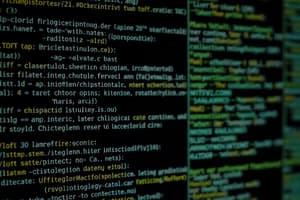Podcast
Questions and Answers
Which of the following best describes the role of a compiler in the context of programming?
Which of the following best describes the role of a compiler in the context of programming?
- To directly execute a program written in a high-level language.
- To interpret and execute a program line by line without any prior translation.
- To translate a program written in a high-level language into machine code directly executable by the CPU. (correct)
- To translate a program into an intermediate code that is later interpreted.
An algorithm must be written in a specific programming language to be considered valid.
An algorithm must be written in a specific programming language to be considered valid.
False (B)
What is the primary difference between compiled and interpreted languages in terms of execution?
What is the primary difference between compiled and interpreted languages in terms of execution?
Compiled languages are translated into machine code before execution, whereas interpreted languages are executed line by line by an interpreter.
In C programming, the ______ function is essential because the execution of any program starts from it.
In C programming, the ______ function is essential because the execution of any program starts from it.
Match the programming language type with its description:
Match the programming language type with its description:
Why are comments crucial in programming?
Why are comments crucial in programming?
A cross-platform program is designed to run only on the operating system it was initially compiled for.
A cross-platform program is designed to run only on the operating system it was initially compiled for.
What is an Integrated Development Environment (IDE), and how does it assist programmers?
What is an Integrated Development Environment (IDE), and how does it assist programmers?
In the context of data representation, an ______ is universally recognized as a sequence of eight bits.
In the context of data representation, an ______ is universally recognized as a sequence of eight bits.
Which of the following is the most accurate description of an algorithm's determinacy?
Which of the following is the most accurate description of an algorithm's determinacy?
Flashcards
Memory
Memory
Stores information as sequences of 0s and 1s (bits).
Octet
Octet
A sequence of 8 bits.
Instructions
Instructions
Orders executed by the CPU, also coded in memory as 0s and 1s.
Executable Code
Executable Code
Signup and view all the flashcards
Programming Languages
Programming Languages
Signup and view all the flashcards
Compiler
Compiler
Signup and view all the flashcards
Interpreter
Interpreter
Signup and view all the flashcards
Algorithm
Algorithm
Signup and view all the flashcards
Program
Program
Signup and view all the flashcards
Pre-processor directives
Pre-processor directives
Signup and view all the flashcards
Study Notes
- The text provides an introduction to the structure of a program
Objectives of the Study Unit
- Acquire a certain way of reasoning.
- Automate problem-solving strategies.
- Master the concepts of algorithms.
- Learn the process of programming without specializing in one particular language.
- Illustrate the concepts with an imperative language, C.
Introduction
- Memory is a place to store binary data.
- An octet (byte) is a sequence of 8 bits.
- Computers need conventions to represent integers, characters, and real numbers with bits and octets.
- Computers use integers, reals, and characters for predefined data objects.
- The CPU executes machine instructions coded in memory as 0s and 1s.
- A series of instructions forms executable code.
- Executable code is binary machine language recognizable by a CPU.
Programming Languages
- High-level languages express data and instructions abstractly.
- The code produced is independent of the computer's architecture.
- Programming languages include:
- Logical languages program proofs based on axioms and logic rules, describing what should be calculated rather than how (e.g., Prolog, Obj3, Coq).
- Functional languages describe a program as a set of function definitions (e.g., OCaml, Haskell).
- Imperative languages explicitly describe successive instructions for the computer to execute on data in memory (e.g., C, C++, Python, Java, Pascal).
- Programs are sets of instructions written in a programming language.
Compilation vs. Interpretation
- Programs must be compiled or interpreted to be executed.
- Compiled programs are translated into executable machine language by a compiler, readable by the CPU, then executed, for example: C, C++, Pascal.
- Interpreted programs are executed directly via an interpreter (such as Python, OCaml).
- Compiled programs run faster and use fewer resources, while interpreted programs are more portable and can run on any platform with an interpreter.
- Some languages are semi-interpreted (like Java), they are compiled into an intermediate code and executed by a virtual machine, which compiles and executes it on the fly.
- Some languages have compilers and interpreters (Ocaml, Haskell), some are compiled (C, C++), and others are interpreted (Python).
- In this course, the language C is used for its imperative compiled features
Algorithms
- Algorithms are a sequence of operations or instructions to solve a problem or achieve a result such as a cooking recipe or GPS directions.
- A program is a translation of an algorithm into a programming language.
- Algorithms predate computers and can calculate the greatest common divisor (GCD), sort lists, or schedule tasks.
- Al-Khwarizmi, a mathematician from Baghdad around the year 800 known for math, also contributed to naming algorithms; also arithmos which gave arithmetic.
- Programs describe algorithms, but algorithms do not depend on the language.
- Algorithms can be written in natural language, represented by a diagram, or given as a mathematical formula.
- An algorithm's characteristics involve:
- Inputting a finite number of data.
- Defining each step rigorously and unambiguously.
- Terminating and providing a result.
- Being deterministic: it must produce the same result with the same input.
Analyst-Programmer Role
- The production chain for an executable program: problem analysis,algorithm design, programming, compilation or interpretation, producing a result.
Programs in C
- A programming language involves rules, grammar, and precise syntax.
Basics of Imperative Programming and the C Language
- An imperative program contains:
- Descriptions of non-elementary types.
- Instructions describing operations in order.
- Combinations of instructions (repetitions, conditionals).
- Instructions in a specific order.
Structure of a C Program
- C programs must be written in a text file, edited, saved with the ".c" extension.
- In C, a program's structure follows this order:
- Preprocessor directives replaced during compilation, such as #include <stdio.h>.
- Definitions of non-elementary types.
- Definitions of functions.
- Only one function is named main where the program execution starts and is mandatory.
- Type definitions are global and usable in all functions.
- Comments:
- Can be added to provide context.
- Are ignored by the compiler
- Can be enclosed between /* and */ for multiple lines
- Use // for single-line comments.
- Comments improve code reusability.
Compilation
- Compile C programs with the command "gcc filename.c -o executable_name", for example, gcc addition.c -o addition.
- Integrated Development Environments (IDEs) include text editors with syntax highlighting and functions for compilation, execution, and debugging.
Studying That Suits You
Use AI to generate personalized quizzes and flashcards to suit your learning preferences.




